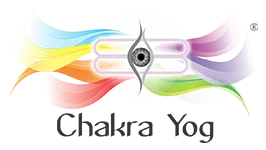Yoga Asanas for Anahata Chakra

The life force energy (known as “prana”) passes through the subtle body through a number of channels known as “nadis” in yoga. These nadis meet at areas of amplified energy known as “chakras.” Chakras are swirling vortexes of energy in the subtle body that correlate to specific glands along the spine and within the head. They are named after the Sanskrit word for “wheel.” When the nadis get blocked due to bad behaviors and old patterns, the chakras become stagnant. The life force becomes sluggish as a result, which may lead to reduced physical, mental, and emotional health. Yoga practice cleanses and revitalizes the nadis and chakras, allowing prana to flow freely again.
Yoga is an incredibly useful method for releasing prana, or life energy, when it becomes wedged. Through yoga poses (asanas) and breathing, yoga dissolves musty energy and allows new energy into our chakra system. As a means of rebalancing our chakras so that they work optimally we may practice yoga as it definitely helps to either activate a blocked chakra or discharge excess energy from a dysfunctional chakra, for example when a chakra becomes overactive.
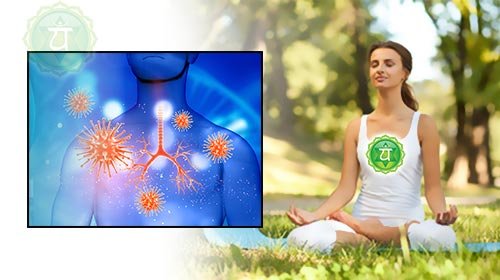
An effective way to bring to balance the Heart (Anahata) Chakra is to resort to yoga asanas practice on a regular basis, which stabilizes and balances your physical body’s energies at this energy vortex which acts as a bridge between the lower and the upper chakras. Makes it simpler to effortlessly create-manifest truly what they desire (and deserve) in life. There is a healthy level of self-acceptance and compassion for oneself as well as for others. This person also desires a spiritual experience in all his actions. The physical manifestation of a healthy Anahata Chakra is a good immune system. Yoga exercises involving the part of the body of this chakra are aimed to dissolve any blockage at this energetic level.
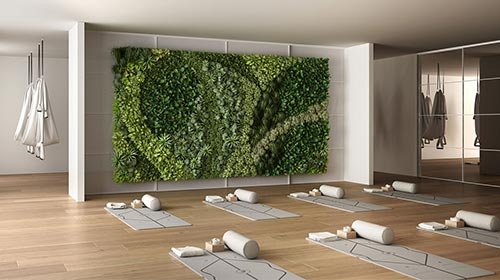
Yoga can be practiced at home, in natural environments or in a yoga studio. At the same time, each chakra is connected with different universal elements being Air, Earth, Water, Ether or Fire. While yoga asanas may be practiced with beneficial results in many distinct surroundings, it is recommended whenever is possible to do these in particular places related to the chakra’s element to enhance the whole experience and results. In the case of Anahata as it is related to the air element and the color green, any natural setting with trees where you can appreciate and hear the sounds of their windy leaves, such as forests or parks, yoga practiced on this places into the open is the first choice to heighten the healing experience of the practice. When this is not doable to perform, we can equally get beneficial results by practicing it at our home, yoga studio or other specifically dedicated similar green space for this practice too.
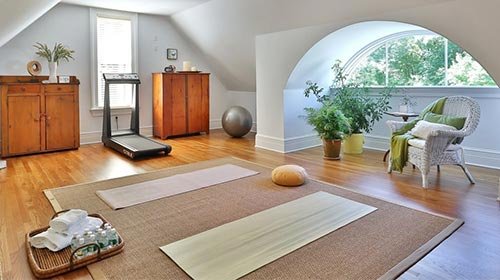
Creating a home yoga studio has several advantages and may take your yoga practice to a whole new and enhanced level. It helps you to immerse yourself in yoga so that it becomes a more important part of your everyday rather than something that is exclusively performed at a studio. Indeed, yoga experts and teachers acclaim contrary to popular belief to practice yoga at your own pace in your own place rather than in busy and distracting public yoga centers which tend to rush the practice in too active modes and with limited time and procedures. They reiterate that the practice of yoga should be paced at each person’s rhythm thus allowing a much better integration of the practice as it involves aspects like focus, absorption, breathing or meditation. Therefore, getting involved in public spaces with yoga experienced teachers is principally suggested mostly to get started with the right postures under their supervision at first, but more personal places and environments are more suitable for yoga practice for the healing and balancing of our energy centers (chakras) in the long-term.
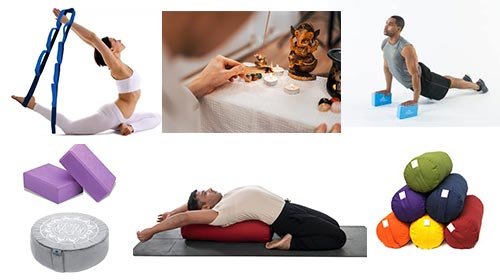
Even in the tiniest of areas, you can carve out a nook and corner for your home yoga studio. The first item you’ll need is a yoga mat, or if you can’t find one, a towel will do. It will protect you from slipping and sliding while you practice yoga.
Below are some other items you may need in your daily yoga practice:
- Yoga Bolsters are used to aid in relaxing, softening postures, and opening up the body. As an alternative, you may make an improvised bolster out of a pillow covered in a blanket. It forms an oval and may be used as a bolster to rest against.
- Yoga Blocks are used to aid in the practice of yoga by bringing the floor closer to you if you are unable to reach it in certain poses. If you don’t have access to yoga blocks, you may use thick books.
- Yoga Straps are used to assist yoga practitioners in achieving a greater range of motion and increased flexibility. Likewise, resistance bands may also be used as an alternative.
- Yoga blankets are great to have on hand since they can help you sit comfortably and relax in restorative positions. As an alternative to yoga-specific blankets, you may use blankets from your bed, throw blankets from your sofa, or towels.
- Yoga cushions and chairs aids in meditation and they are utilized to keep the body in a comfortable sitting posture. They tilt the pelvis, allowing you to sit erect and securely in meditation position. If they are not accessible, you may sit on any cushion from your home, such as one from your sofa or bed, while meditation.
- Altars and the things that decorate them are utilized to integrate the energy of your yoga practice into your surroundings. Deities’ sculptures and sacred symbols and pictures are often placed.

Begin your practice by sitting. Close your eyes and focus your concentration on your heart. Take some time to be calm and silent, and observe your deepest self. Drop beneath the buzz of your mind into the cave of your heart and listen for
the inner voice. It takes work to become silent and open enough to connect intimately with your inner self. You will gradually be able to recognize the difference between the inner voice of your heart and the neurotic chatter of your mind if you practice listening in on a regular basis. You will be able to see both over time. This inner listening develops discrimination. Discrimination encourages wise decisions that take you to your heart’s calling, your mission. As a consequence, you will include compassion and love into all you do.
Anahata (Heart) is the awakening and realization of your ability to see love unconditionally, and spread your light which manifests loving relationships and being in this frequency manifests your heart’s closest desires and dreams. In essence, this chakra uncovers your qualities of unconditional love and light, which is becoming compassionate, empathetic, loving (together with self-love), harmonious, forgiving, and a master at manifestation.
USTRASANA (Camel Pose)
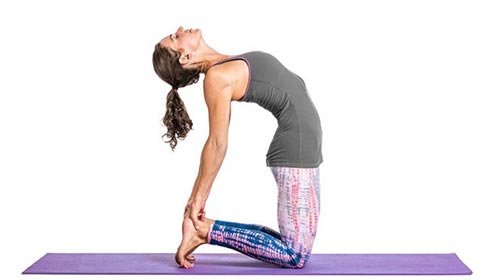
Camel pose is the most popular and practiced asana for to open Anahata. Camel is a backbend of the upper spine caused by a constriction of the belly and a spreading of the chest. Come to a shin stand with your knees hip-width apart or closer. Bring your hands to your hips and press your legs and pelvis down while raising your low belly, ribcage, and chest. Curl up and backwards as you extend one hand, then the other, to contact the appropriate foot. Once in the position, lower the thighs while lifting the back of the ribcage up. Lengthen from the outside hip to the ribs to provide as much room as feasible in the side waist. Bring the tailbone and pubic bone together. Finally, as long as it does not create neck discomfort, slowly lower your head back. Spend around three breaths in this stance and then repeat it three times. When you’re through, lean back on your heels, shut your eyes, and experience the sensation of being alive in a body that’s open-hearted.
URDVHA MUKHA SVANASANA (Upward-Facing Dog)
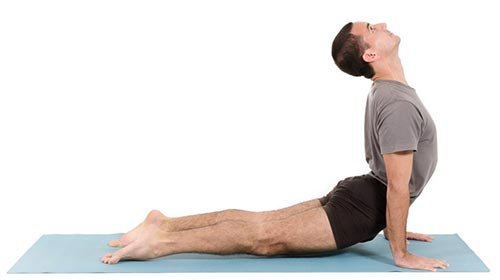
Lie on your stomach and feel your back body soften into your front body. Allow this minute to offer relief and flexibility to the low back, kidneys, and lungs. Extend your legs back long and powerful, and spread your toes and foot soles broad. Legs should be no broader than hip width. Bring your hands beneath your shoulders and start lifting the heart off the floor. Lift a respectable amount while keeping your elbows bent and your pubic bone on the floor, and then wait. Soften the back body once more. Then, pressing the tops of the feet and hands straight down, begin to lift the heart higher, allowing the hips and thighs to come off the floor until the hands and feet are the only points of contact. To open the heart, curl the upper spine in and up while pulling the upper arm bones back. Take two deep breaths here and then relax.
SETU BANDHA SARVANGASANA (Bridge Pose)

Lying on your back, bring your heels to your sitting bones and arms by your sides with palms face up, as you lift your hips up toward the sky. You can stay here or interlace your fingers beneath you. Tuck your upper arm bones in toward center to help open your chest. Now drive down through your feet, outer arms, and pinky edges of your hands to evenly lift the spine. This pose is part of your warm down so stop short of your edge and keep it friendly. Place a block under your sacrum for a supported, more restorative version of the pose. Spend 5 breaths in this pose and then rest.
CAMATKARASANA (Wild Pose)

Lift your right leg up and back from Downward-Facing Dog. Stretch the right quadriceps, hip flexors, and belly by opening the right hip and bending the right knee. You have the option of remaining or continuing. Touch your right foot down behind you as you turn your heart up, and your right hand raises off the floor as you proceed. Then raise your right arm above. Press deeply into your foundation to assist in lifting the back body and spine. This is a significant heart opening that demands some trust, guts, and practice, so build up to it gradually if necessary. You will only stay here for 2-3 breaths before flipping back to Downward Dog and switching sides.
ANJANEYASANA (Low Lunge)
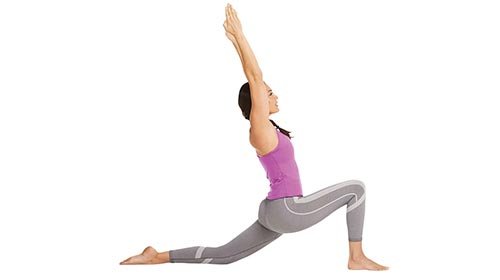
Step your right foot forward from Downward-Facing Dog (Adho Mukha Svanasana). Gently lower your left leg to the floor and raise your arms into a Low Lunge. Square your hips to the front of your mat. Reach your right arm up and bring your left hand to your left hip. You may either remain here or move your left hand down the inside of your left thigh as you curve your spine back, in, and up to open the heart and enter a deeper backbend. Then, aggressively push your left hand into the inner right thigh, and as the leg and hand oppose each other, you will feel stronger and prevent sinking into the low back. Hug your left knee and right foot in toward each other isometrically; this will elevate the pelvic floor and help you bring your low belly up and up. Finally, push down with your right foot and let your heart to rise a bit higher. Take 5 deep breathes here.
ANJANEYASANA variation (Low Lunge variation)
Step your right foot forward into a Low Lunge from Downward-Facing Dog and rest your left knee on the floor. Maintain your left hand’s position while reaching your right arm back. Place your left foot and catch it with your right hand. Allow the left foot to move the shoulder and heart into a deeper openness. External rotation is achieved by corkscrewing your left arm bone to the left. Keep your collarbones apart and your heart open. Spend 3–5 breaths here.
Restorative Yoga poses for Anahata:
Restorative yoga poses are practiced always at the end of the yoga practice to provide rest to the body and self-assimilation of the yoga asanas previously done. They are all about slowing down and incorporating what has been done.
RECLINING BOUND ANGLE POSE (Supta Badda Konasana)

Lie on your back with your legs drawn in to your chest. Take a couple of deep breaths there. Then, put your feet to the floor and let your knees fall away from the center, bringing your foot’s soles together. If this causes pain or discomfort in your knees, consider laying a stack of blankets, cushions, or a bolster under each leg. Bring one hand to your heart and the other to your belly once your legs are comfortable. Allow yourself this opportunity to relax into the heart energy by closing your eyes. Intentionally attract this wellspring of love, compassion, and pleasure into all you do.
CHILD POSE (Balasana)
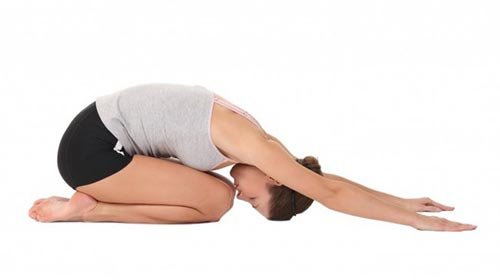
Bring your knees to the floor from Downward-Facing Dog. Place your sitting bones back on your heels and slowly lower your brow to the ground. This will provide a warmth compression to the abdomen. Allow your whole body to soften. Allow the abdominal wall to totally relax, as if it were a buddha belly. Deeply relax. Take 5–8 deep breaths in this stance.
CORPSE POSE (Savasana)

When you’re finished, fall back in Savasana and allow your body to relax as if you’re floating on top of water, drifting into a tranquil and pleasant repose.
Aside from the yoga positions outlined above, cultivating a deeper feeling of steadiness throughout your practice may take various forms. If visualizations have previously benefited you in your practice, consider imagining or wearing the color green, which is the color of the Heart (Anahata) Chakra. This vision may assist you in rekindle your inner flame revealing a stronger connection while practicing the above yoga asanas. Singing mantras and also using sound vibrations in the background is another excellent approach to connect with your Heart (Anahata) Chakra while doing yoga.


